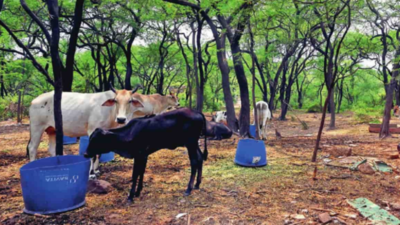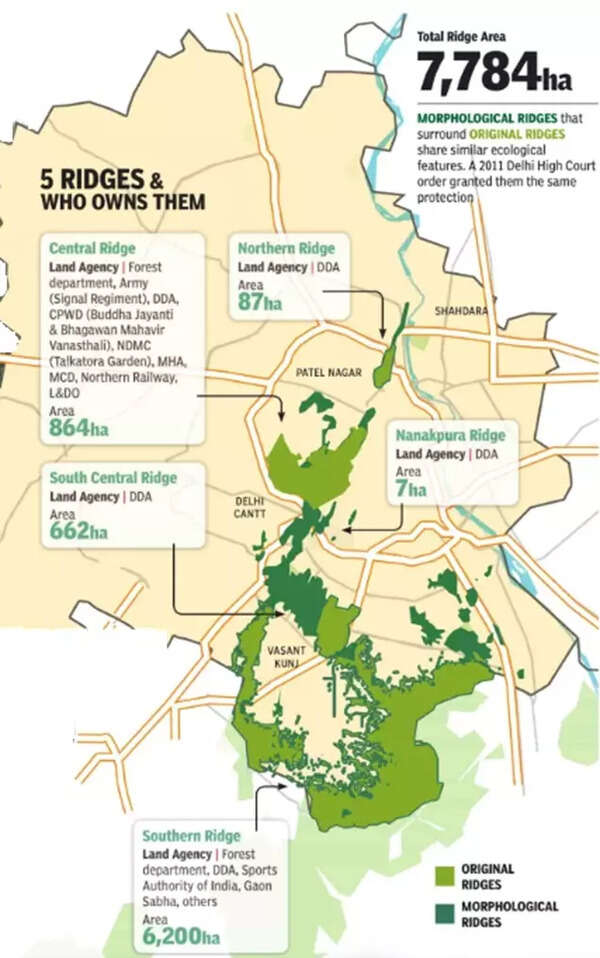ARTICLE AD BOX

For over two decades, the Ridge has been defended by courts, conservationists and citizen groups. Yet its decline hasn’t stopped. Delhi’s ecological shield is now a casualty of bureaucratic apathy, encroachments and token enforcement.As the city chokes on its own pollution every year, its natural air purifier, the Delhi Ridge, is struggling to remain intact in the face of relentless expansion and commercialisation.The Ridge lies at the tail end of the nearly 1,500-million-year-old Aravalis that stretch from Gujarat, traverse Rajasthan and Haryana, and finally end in Delhi. With burgeoning construction and unauthorised settlements, the Ridge, often called Delhi’s green lungs, is gradually fading.
In its southern reaches, especially, it fights a fierce battle for survival.Just beyond the boundary of Asola Bhatti Wildlife Sanctuary, a vital refuge for leopards and myriad species of birds and animals, Sanjay Colony offers a picture of stark contrast. Over the past few decades, this densely packed human settlement has grown rapidly, pushing its way into the Southern Ridge.

A spot visit by TOI revealed a colony dotted with concrete structures and commercial establishments, with only a few fragments of wilderness left.
Similarly, at Asola village in the Southern Ridge, over 38 hectares are encroached upon. Indigenous trees, thorny bushes and ancient rocks have been replaced by manicured lawns of sprawling farmhouses. Carving out private estates from ridge land, Asola village is now synonymous with colossal gates and high walls of lavish farmhouses.It’s not just private structures; govt buildings have come up in the area too. Against a backdrop of trees, Maidan Garhi police station in the Southern Ridge has single-storey structures with concrete walls and a tin roof. During a visit, TOI found many vehicles parked on the campus.
When contacted, there was no response from Delhi Police.As per a 1994 Delhi govt notification under Section 4 of Indian Forest Act, these are forest lands. Defining the boundaries of Northern, Central, South-Central and Southern Ridge, the notification declared “all forest lands and wastelands which is govt property” within these specified regions would be classified as “reserved forest”.

The four Ridges, spread over about 7,777 hectares, were declared Ridge Reserve Forest.
In 1996, Delhi govt notified a 7-hectare area as Nanakpura Ridge, taking the total notified Ridge Reserve Forest to 7,784 hectares.Apart from the notified five Ridges, Delhi has a Morphological Ridge with similar physical and ecological features. An Introduction to Delhi Ridge , a book published by Delhi forest and wildlife department in 2014, says the Morphological Ridge is described on the basis of seismic zonation provided by Geological Survey of India Map of Delhi of 2006. “Though falling outside the notified Ridge forest land, it has Ridge-like features in respect of Aravali outcrop and vegetative cover,” says the book. It is granted the same level of protection following a 2011 Delhi high court order, which stated lands outside the notified Ridge areas, but with morphological features conforming to the Ridge, should be given the same protection as the notified Ridge area. Though it is not officially designated as a reserve forest under section 4 of Indian Forest Act, the approval of Ridge Management Board, Central Empowered Committee and the Supreme Court is required for undertaking any construction activity in Morphological Ridge.

In a landmark judgment in 1996, the Supreme Court noted Delhi had two distinct features: “The Ridge, which is the rocky outcrop of Aravali Hills and the river Yamuna. Some parts of the Ridge have been erased in the central city area. No further infringement of the Ridge is to be permitted; it should be maintained in its pristine glory.” However, not much has been done on the ground to save the city’s Ridges in the past three decades, which remain “unprotected”.
For full legal protection, the Section 4 notification should be followed by notification under Section 20 of Indian Forest Act after demarcation and settling of land rights. Though the Ridge areas were notified under Section 4, the final notification under Section 20 is pending even after 31 years. Even the management and ownership of Ridge reserve forest are under multiple agencies.There was no immediate response from the forest department.

In 2013, activist Sonya Ghosh filed a plea in the National Green Tribunal seeking protection of the Ridge. The tribunal, in an order dated Jan 15, 2021, directed Delhi govt through the chief secretary to ensure the Section 20 notification within three months. It also directed the identification of the remaining area and an action plan for removing the encroachment within the next three months.However, encroachment removal from the Southern Ridge is progressing at a slow pace.
Following demarcation by the revenue department, 398.6 hectares were identified as encroached in 2019, encompassing 18 villages that are home to lakhs of people. Of this, encroachment of only 91 hectares was removed till March 18 this year. On other Ridges, the extent of encroachment is still unknown. “It can be known only after demarcation,” said a senior forest official.“South-Central, Northern, Nanakpura and Central Ridges are yet to be demarcated on the ground.
The forest and wildlife department has written to the revenue department and other land-owning agencies for joint demarcation,” said a March 18 affidavit filed by Delhi govt in NGT through the principal secretary (environment and forests). “Villages comprising the Southern and South-Central Ridges have been urbanised… However, urbanisation does not change the status of forest land. In 74 matters, different courts have granted a stay in respect of the demolition of encroachment over forest land in the southern ridge,” it added.Claiming “no concrete action” has been taken so far to remove encroachments from the Southern Ridge, Ghosh, who filed the case in NGT, said, “The forest department needs police backup for anti-encroachment drives, but it doesn’t get the assistance. Besides, there is political interference, and bastis came up in ridges with the support of politicians."Sanjay Colony, she added, was to be removed on Supreme Court orders and alternate housing provided, but the authorities hadn't yet acted on the matter.In an affidavit dated April 5, Delhi forest and wildlife department informed NGT it will conduct the final Section 20 notification of the Southern Ridge, spread over 6,200 hectares, in three phases. The first phase encompasses roughly 3,300 hectares, for which a file was recently submitted to Delhi govt for final notification. This portion comprises forest land without encroachment or any pending litigations. Under Phase II, areas with encroachment but no pending litigations would be notified.
The remaining parts would be notified in Phase III.Apart from encroachment, the Ridge is also under threat from cutting of trees for infrastructure projects. Last year, a plea was filed in SC claiming hundreds of trees were illegally felled for the widening of the road to the under-construction Central Armed Police Forces Institute of Medical Sciences. SC imposed a Rs 25,000 fine on each DDA official found responsible for cutting 1,670 trees without the court’s nod over their “contemptuous act”.
The courts have been pulling up govt agencies for the past few years. HC in March this year lamented that “Delhi's agencies don't appear to be serious about protecting ridge forests”.The apex court’s Central Empowered Committee (CEC), in a report dated Sept 4 last year, said only five out of 20 govt projects whose conditional permission was given by the apex court for tree felling or translocation in the Ridge area from 2016 onwards complied with the terms.
Among the conditions not met were compensatory plantation and the creation of a green belt at the site. “The project proponents are interested in complying with norms until trees are felled or translocated, and after the construction starts, they pay no heed to other conditions,” CEC said.In another report dated May 8, 2025, CEC found that the Ridge Management Board (RMB) approved 39 projects to carry out work in Ridge areas from 2015 onwards.
It diverted 301.8 hectares of land — around 4% of Ridge area — for construction work. RMB was constituted on SC orders in 1995 under the chief secretary’s chairmanship to ensure the “Ridge is not occupied or encroached by any person for any authorised purpose”. However, in 2024, SC restrained it from clearing any project proposals for the diversion of Ridge forests without seeking its permission. On May 26 this year, SC suggested setting up a single “consolidated” authority to manage the Ridge.According to environmentalist Bhavreen Kandhari, “Ridge forests are under mounting pressure, not just from encroachments, but also from sanctioned developments like cafés, toilets and event spaces that erode their ecological sanctity. While authorities are removing unauthorised structures in areas like Sanjay Van, they are simultaneously introducing commercial amenities. This contradictory approach highlights the urgent need for clear demarcation of the Ridge.
”Delhi HC, she added, had directed the formation of a committee to oversee the demarcation and protection of these vital green spaces. “Without precise boundaries and unified management, the Ridge remains vulnerable to piecemeal degradation,” said Kandhari.CR Babu, professor emeritus and head of Centre for Environment Management of Degraded Ecosystems, said infrastructure development, encroachments and the dominance of invasive species were ailing the Ridge. “The British first brought Vilayati Kikar (Prosopis juliflora) from Mexico to Rajasthan in 1857 to make it green. They then introduced it in Delhi and broadcast its seeds in the Ridge. Nearly 150 years later, Vilayati Kikar is dominating the Ridge and eliminating the native species and their habitats, including moisture level in the soil, microflora and water level. Other invasive species, Lantana and Subabul, are also present in the Ridge,” said Babu.
He said if the Aravalli Biodiversity Park model was adopted in the 22km floodplain of Yamuna and the Ridge restored to its natural glory, Delhi’s environmental problems, including pollution, urban heat island effect and urban flooding, would be resolved.“An Introduction to Delhi Ridge” says the Ridge acts as a barrier to the sandladen westerlies from the deserts of Rajasthan, protecting Delhi from desertification. “With increasing encroachment and felling of trees, this natural filtration system of the Ridge is weakening. Dust storms have become more frequent, and Delhi’s air quality has plummeted further, exacerbating respiratory illnesses among residents,” said Kandhari.
Get the latest lifestyle updates on Times of India, along with Eid wishes, messages, and quotes !



.png)
.png)
.png)
















 15 hours ago
3
15 hours ago
3









 English (US) ·
English (US) ·